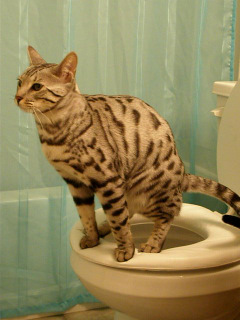Dangers of Flushing Cat Poop Down Your Toilet - Prevent Potential Problems
Dangers of Flushing Cat Poop Down Your Toilet - Prevent Potential Problems
Blog Article
They are making a few great pointers on Don’t flush cat feces down the toilet overall in the content underneath.

Intro
As pet cat owners, it's important to be mindful of exactly how we deal with our feline close friends' waste. While it may appear practical to purge feline poop down the commode, this method can have destructive repercussions for both the environment and human wellness.
Environmental Impact
Flushing feline poop presents hazardous microorganisms and bloodsuckers right into the supply of water, presenting a substantial threat to marine ecological communities. These contaminants can adversely influence marine life and concession water quality.
Health and wellness Risks
Along with ecological worries, purging cat waste can also pose health threats to human beings. Feline feces may consist of Toxoplasma gondii, a bloodsucker that can create toxoplasmosis-- a potentially serious ailment, specifically for pregnant ladies and people with weakened immune systems.
Alternatives to Flushing
Thankfully, there are safer and a lot more accountable means to deal with pet cat poop. Consider the adhering to alternatives:
1. Scoop and Dispose in Trash
One of the most common technique of disposing of pet cat poop is to scoop it into a naturally degradable bag and toss it in the trash. Make certain to use a devoted trash inside story and dispose of the waste quickly.
2. Usage Biodegradable Litter
Choose naturally degradable feline trash made from products such as corn or wheat. These clutters are environmentally friendly and can be safely dealt with in the trash.
3. Bury in the Yard
If you have a yard, take into consideration hiding pet cat waste in a designated area away from vegetable yards and water resources. Be sure to dig deep adequate to stop contamination of groundwater.
4. Mount a Pet Waste Disposal System
Invest in an animal garbage disposal system especially created for cat waste. These systems make use of enzymes to break down the waste, reducing odor and ecological influence.
Verdict
Responsible family pet possession expands beyond providing food and sanctuary-- it also entails proper waste administration. By avoiding flushing pet cat poop down the toilet and selecting alternative disposal techniques, we can lessen our ecological impact and safeguard human health and wellness.
Why Can’t I Flush Cat Poop?
It Spreads a Parasite
Cats are frequently infected with a parasite called toxoplasma gondii. The parasite causes an infection called toxoplasmosis. It is usually harmless to cats. The parasite only uses cat poop as a host for its eggs. Otherwise, the cat’s immune system usually keeps the infection at low enough levels to maintain its own health. But it does not stop the develop of eggs. These eggs are tiny and surprisingly tough. They may survive for a year before they begin to grow. But that’s the problem.
Our wastewater system is not designed to deal with toxoplasmosis eggs. Instead, most eggs will flush from your toilet into sewers and wastewater management plants. After the sewage is treated for many other harmful things in it, it is typically released into local rivers, lakes, or oceans. Here, the toxoplasmosis eggs can find new hosts, including starfish, crabs, otters, and many other wildlife. For many, this is a significant risk to their health. Toxoplasmosis can also end up infecting water sources that are important for agriculture, which means our deer, pigs, and sheep can get infected too.
Is There Risk to Humans?
There can be a risk to human life from flushing cat poop down the toilet. If you do so, the parasites from your cat’s poop can end up in shellfish, game animals, or livestock. If this meat is then served raw or undercooked, the people who eat it can get sick.
In fact, according to the CDC, 40 million people in the United States are infected with toxoplasma gondii. They get it from exposure to infected seafood, or from some kind of cat poop contamination, like drinking from a stream that is contaminated or touching anything that has come into contact with cat poop. That includes just cleaning a cat litter box.
Most people who get infected with these parasites will not develop any symptoms. However, for pregnant women or for those with compromised immune systems, the parasite can cause severe health problems.
How to Handle Cat Poop
The best way to handle cat poop is actually to clean the box more often. The eggs that the parasite sheds will not become active until one to five days after the cat poops. That means that if you clean daily, you’re much less likely to come into direct contact with infectious eggs.
That said, always dispose of cat poop in the garbage and not down the toilet. Wash your hands before and after you clean the litter box, and bring the bag of poop right outside to your garbage bins.
https://trenchlesssolutionsusa.com/why-cant-i-flush-cat-poop/

I stumbled upon that piece of writing on Don’t flush cat feces down the toilet while doing a lookup on the search engines. Feel free to set aside a second to distribute this blog entry if you liked it. I enjoy reading our article about Can You Flush Cat Poop Down The Toilet?.
View Website Report this page